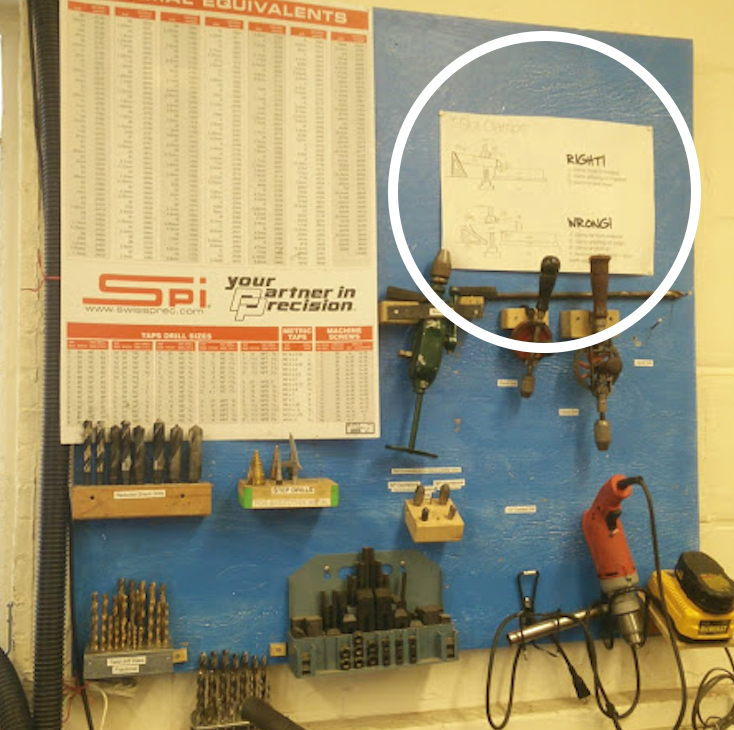
Patina, you (almost) always need more!
Patina is physical signage and artifacts made by your community members that come in two primary forms: Safety and Culture.
Why Patina?
Establishing the process and guidelines for how your community develops a "patina" in your creative space is a critical step in fostering an environment that reflects and amplifies the diversity and creativity of its culture. Through the intentional design of physical artifacts such as labels, signage, and interactive learning tools, "patina" captures and communicates the stories, interactions, and contributions of those who inhabit the space. This intentional layering of human experience transforms a functional environment into a dynamic, living ecosystem where inclusivity and shared ownership are visible and celebrated. Moreover, these processes ensure that the space evolves as a rich, humanistic hub of innovation and learning, where past contributions inform and inspire the future.
Generally, “patina” comes in two forms: Safety and Culture.
1. Safety Patina:
A safety "patina" in a creative space refers to the visible, evolving evidence of safety practices and protocols developed by community members to actively shape their environment. A safety patina represents the cumulative impact of consistent safety measures and community engagement. It includes features such as labeling on equipment for proper use, adjustments to layouts to improve accessibility and reduce risks, and worn areas indicating high activity and frequent interaction. This patina serves as a tangible, ever-present feedback system, reminding users that safety is a living, integral part of the space's culture. It transforms abstract rules into a shared, visible experience, reinforcing a sense of accountability and promoting a culture where safety is second nature.
-

On Tool, Personal Safety
This describes the hazard and the correct operation to avoid physical harm. On Tool is a label affixed directly to a tool.
-

Near Tool, Personal Safety
This often describes the best practices as step-by-step equipment operation from the beginning to the end of a procedure.
-

Near Tool Equipment Operation
These are located near a tool such as this Emergency Stop and the floor arrows.
-

Shop Information
Such as “Please, clean up after yourself,” shop hours, or training sign-up sheets.
2. Culture Patina:
A culture "patina" in a creative space refers to the intentional and organic layering of stories, interactions, and contributions that shape the identity and character of the space over time. It emerges through the thoughtful design and placement of physical artifacts—such as labels, signage, and interactive tools—that capture the diverse experiences and creativity of the community. This "patina" transforms the space from a purely functional environment into a vibrant, living ecosystem where inclusivity, shared ownership, and human connection are celebrated. It evolves dynamically as users personalize their interactions with the space, leaving behind traces of creativity and collaboration that reflect their collective values and engagement. Ultimately, this cultural layering fosters a sense of belonging and turns the maker space into a rich, humanistic hub of innovation and learning.
-
RISD CoWorks
RISD CoWorks (2019) is one of the first interdisciplinary non-major specific collaborative spaces in the art and design school education space. Even before entering Coworks, stakeholders, the patina signals the social, political, and teaching/learning values inside.
-
Northeastern University’s LGTBQA+ Center
The LGBTQA Resource Center calls out its organized and empowered LGBTQA community at Northeastern through a huge range of artworks and artifacts.
-
The Weissman Foundry
At the Weissman Foundry, posters, stickers, and artifacts define a welcoming culture of diverse backgrounds, “Tea,” hanging out and making. Blending these signals into a single location defines, “We are a diverse, sharing community, and you are welcome here!”.
Similarly, large-scale signage, giveaways, and unique marketing campaigns become part of a thoughtfully designed patina to differentiate your creative space.
-

Inviting the Community to Participate
The PomPom Project both defined the goals of the space while encouraging folks to authentically join the community by making something person and connecting it to the space.
Artwork: Julio Le Parc, Continuous light cylinder of the "Enlightenment Series," 1962



